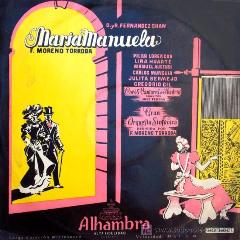Federico Torroba – Maria Manuela (1957)
Federico Torroba – Maria Manuela (1957)

1. Part I 2. Part II María Manuela - Pilar Lorengar Mercedes - Lina Huarte Gonzalo - Manuel Ausensi Lorenzo - Carlos Munguía Petrilla - Julita Bermejo Amadeo - Gregorio Gil Cantores de Madrid Gran Orquesta Sinfónica Federico Moreno Torroba – conductor
Moreno Torroba was not only a prolific guitar composer but one of the leading advocates in the late flowering of the zarzuela, the light Spanish opera form characterized by a blend of sung and spoken dialect. As conductor and impresario, he travelled widely throughout the 1930s and 1940s with several stage companies, visiting the United States and Latin America. His first zarzuela was written as early as 1912, but it was the success of La mesonera de Tordesillas (The Hostess of Tordesillas) (1925), which confirmed his enthusiasm for the genre, and a whole string of triumphs, including La marchenera (The Girl from Marchena) (1928) and Luisa Fernanda (1932) followed, continuing through till Ella (1966), the composer finally achieving an astonishing total of some eighty operas.
After the end of the Spanish Civil War in 1939, Moreno Torroba continued as one of the dominant figures of Spanish musical culture. Founding a new zarzuela company in 1946, he once again toured widely and in 1957 María Manuela became the most popular Spanish opera of the decade. In the post-war years, the composer wrote nine ballets, a quantity of choral and orchestral music, a piano concerto and many piano solos, a variety of songs and miscellaneous other works, as well as numerous guitar pieces, a prodigious output which continued until his death at the age of 91. Moreno Torroba’s musical vocabulary eschewed experimentation along twentieth-century avant-garde lines, preferring lyrically melodic music with tonal harmony. His philosophy of composition is often described as ‘castizo’, signifying a blend of folk elements drawing on the traditions of Iberian culture, combined with conventional forms and evocative or impressionistic works celebrating dance genres, specific places, or moods. His guitar music is particularly rich in its use of colour, melody, and lively rhythms to transport the listener into an essentially Spanish expression of a poetic and romantic sensibility. --- naxos.com
download: uploaded yandex 4shared mediafire solidfiles mega zalivalka filecloudio anonfiles oboom








